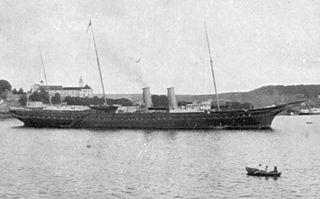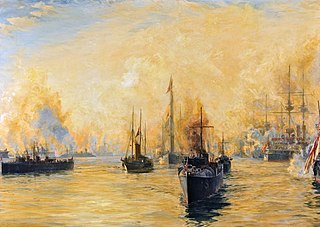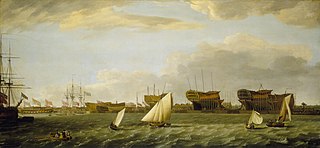Four vessels of the British Royal Navy have been named HMS Victoria in honour of Queen Victoria:
Victoria and Albert refers to Queen Victoria and her husband, Prince Albert of Saxe-Coburg-Gotha.

HMY Victoria and Albert was a twin-paddle steamer launched 25 April 1843. She functioned as a royal yacht of the sovereign of the United Kingdom, owned and operated by the Royal Navy, and was the first of three royal yachts to be named Victoria and Albert. She was laid down in 1842 at Pembroke Dock and was designed by William Symonds. She measured 1,034 tons burthen, carried two guns, and was the first royal yacht to be steam powered, being fitted with a 430 horsepower (320 kW) engine.

HMY Victoria and Albert, a 360-foot (110 m) steamer launched on 16 January 1855, was a royal yacht of the sovereign of the United Kingdom until 1900, owned and operated by the Royal Navy. She displaced 2,390 tons, and could make 15 knots on her paddles. There were 240 crew.

HMY Victoria and Albert was a royal yacht of the Royal Navy of the United Kingdom. The yacht was designed by the Chief Constructor of the Royal Navy Sir William White, launched in 1899 and ready for service in 1901. This was the third yacht to be named Victoria and Albert and she was fitted with steam engines fired by Belleville water-tube boilers. She served four sovereigns, and was decommissioned as royal yacht in 1939, served in the Second World War, and was broken up in 1954.

HMY Osborne was a paddle steamer Royal Yacht of the Royal Navy of the United Kingdom. Designed by Edward James Reed, she was launched on 19 December 1870 at Pembroke Royal Dockyard and replaced the yacht of the same name formerly known as HMY Victoria and Albert.

HMY Alberta was a royal yacht of the Royal Navy of the United Kingdom. She was built by Pembroke Dock and launched in 1863.
Six ships of the Royal Navy have borne the name HMS Windsor Castle, after Windsor Castle, an official residence of the British monarch:

William and Mary often refers to:

Blackwall Yard is a small body of water that used to be a shipyard on the River Thames in Blackwall, engaged in ship building and later ship repairs for over 350 years. The yard closed in 1987.

HMYFairy was a small royal yacht and tender to the HMY Victoria and Albert (1843). Built in 1844 by Ditchburn and Mare at Leamouth, she was commissioned in 1845.
Two royal yachts of the British monarchy have been named HMY Royal Caroline:
HMY Osborne is the name of two British Royal Yachts:
Britannia may refer to any one of a large number of ships:
Seven ships of the Royal Navy have borne the name HMS Victor:

The Derzhava was a royal yacht of the House of Romanov. It was laid down in 1866 and launched in 1871. The Derzhava and the Livadia were the last wooden paddle steamers built for the Romanovs. The Derzhava served the Romanovs until 1898, when she was converted into a training ship and renamed Dvina.
Several ships of the Royal Navy have been named HMS Fairy:

HMS Dwarf was launched in 1840 as the mercantile Mermaid. The Royal Navy purchased her in 1843 as the Navy's first screw-propelled vessel. She was broken up in 1853.

HMS Penelope was first laid down as one of the many sail frigates that England built to a French model. She was then changed to a unique steam paddle frigate. For some time she was a very famous ship, having a claim to being the first steam frigate. In the end the promise that she would be the first of a line of true steam paddle frigates proved false.
This page is based on this
Wikipedia article Text is available under the
CC BY-SA 4.0 license; additional terms may apply.
Images, videos and audio are available under their respective licenses.










